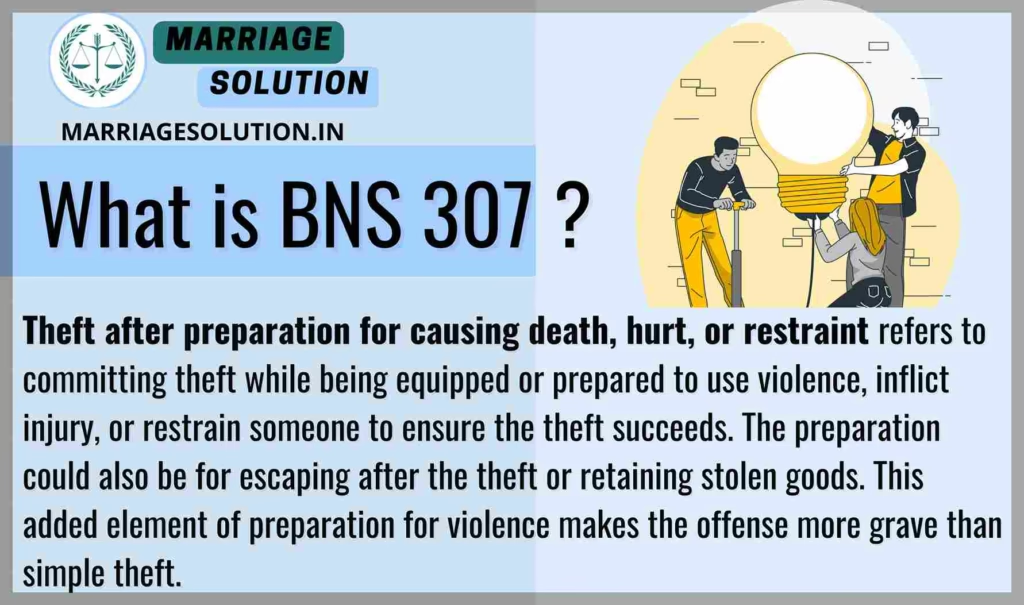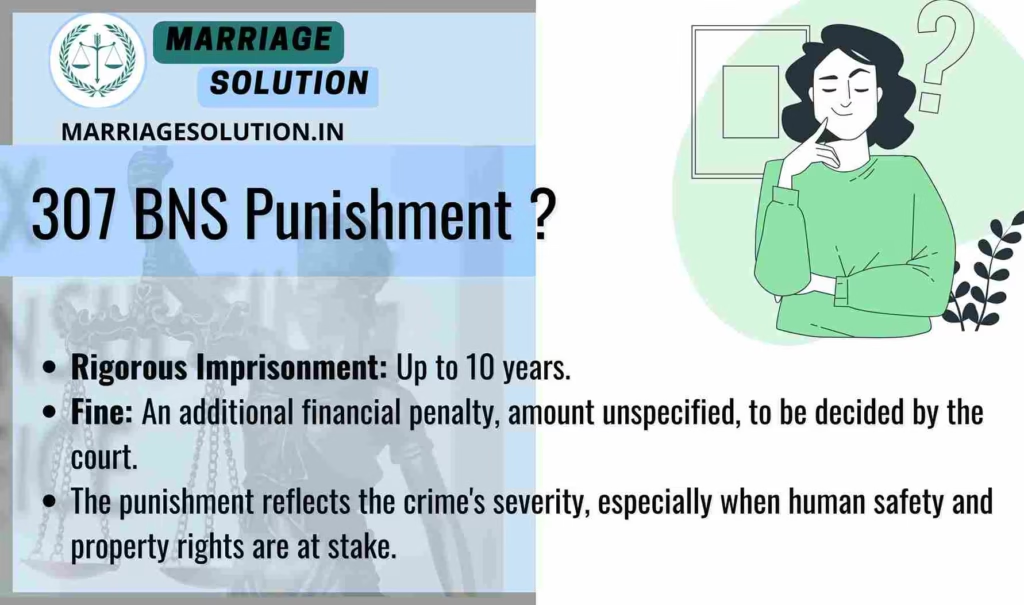Introduction of 307 BNS
307 BNS addresses a serious form of theft where the offender prepares to cause death, hurt, or restraint to facilitate the crime. This section applies not only during the act of theft but also during escape or retaining stolen property. It highlights the severity of theft combined with violence or the threat of violence, distinguishing it from regular theft. This provision ensures stringent punishment to deter criminals from using dangerous means to commit theft or escape justice.
The Bharatiya Nyaya Sanhita (BNS) Section 307replaces the old Indian Penal Code (IPC) Section 382.
What is BNS Section 307 ?
Theft after preparation for causing death, hurt, or restraint refers to committing theft while being equipped or prepared to use violence, inflict injury, or restrain someone to ensure the theft succeeds. The preparation could also be for escaping after the theft or retaining stolen goods. This added element of preparation for violence makes the offense more grave than simple theft.

Under Section 307 of the bns act 2023
Whoever commits theft, having made preparation for causing death, hurt, or restraint, either during the commission of such theft, while escaping after the act, or for retaining stolen property, shall be punished with rigorous imprisonment up to ten years, and shall also be liable to fine.”
1. Meaning of Theft after Preparation for Violence
This section punishes theft where the offender prepares to use deadly force, cause injury, or restrain a person in order to commit the crime.
- The preparation may be before or during the theft.
- It also applies if the offender makes such preparation for escaping or keeping stolen goods.
- The law treats this as a serious and aggravated form of theft since it threatens human safety.
2. Who is Covered?
This section applies to:
- Armed Thieves – carrying weapons (knife, gun, etc.) while committing theft.
- Accomplices – keeping associates ready to restrain or attack victims during the crime.
- Escape Preparations – planning to harm or injure while fleeing after theft.
- Retainers of Stolen Property – threatening or hurting others to keep stolen goods.
3. Nature of the Offense
- Cognizable → Police can register FIR and arrest without warrant.
- Non-Bailable → Bail is not a right; only a court can decide.
- Non-Compoundable → Cannot be privately settled; must go to trial.
- Triable by Magistrate of the First Class → Due to seriousness of offense.
4. Examples of BNS Section 307
- Example 1 – Theft with Weapon
A enters B’s house to steal jewelry and keeps a loaded pistol ready to threaten B in case of resistance. → Offense under Section 307. - Example 2 – Escape with Violence
C snatches a wallet in a crowded street and signals his accomplices to hold down anyone who tries to catch him. → Covered under Section 307.
5. Punishment under BNS Section 307
- Rigorous Imprisonment → Up to 10 years.
- Fine → Additional monetary penalty (amount decided by court).
- Court’s discretion → Both imprisonment and fine may be imposed.
6. Importance of BNS Section 307
- Protects society from violent forms of theft.
- Safeguards individuals against threats to life and safety during theft.
- Ensures stringent punishment for criminals who go beyond simple theft.
- Acts as a deterrent to organized and armed thefts.
307 BNS act Overview
BNS Section 307 addresses theft where preparations have been made to cause death, hurt, or restraint to ensure the theft is successfully executed. It also covers acts done to escape after the theft or retain stolen property. This section recognizes the premeditated risk to human life or safety in committing such theft. Offenders who plan or prepare to use harm, fear, or restraint are penalized under this section. It aims to protect individuals from violent or forceful theft incidents. The law prioritizes the safety and security of individuals over mere property loss.
BNS Section 307 :10 Key Points
1. Theft in Specific Locations
This section specifically addresses theft committed in buildings, tents, or vessels that are either used as residences or for safeguarding property. It distinguishes this type of theft from other thefts due to the violation of personal space. The law recognizes the heightened sense of insecurity caused by such intrusions, making this offense more severe than general theft.
2. Violation of Privacy
The law considers theft in a dwelling or place where people live or store valuable belongings as an aggravated crime. Such theft is not merely about property loss but also about invading someone’s private and safe space. This invasion disrupts the sense of security people expect in their homes or places of work.
3. Punishment Reflects the Severity
The punishment for theft under this section includes rigorous imprisonment for a term that may extend to 7 years, along with a fine. The severity of the punishment reflects the dual harm caused by property loss and the breach of trust and security in private spaces. It aims to deter criminals from targeting such places.
4. Covers Diverse Settings
This section is not limited to theft in buildings; it also includes tents and vessels used as dwellings or for storing property. This ensures protection for all types of living spaces and property-holding arrangements, including temporary or mobile setups, acknowledging their importance to individuals and businesses.
5. Recognizes Risk to Occupants
The law takes into account the potential risk to human life during thefts in inhabited places. While theft may involve only property damage, the presence of people in these locations increases the chances of confrontation, harm, or intimidation, making the crime more dangerous and impactful.
6. Categorization as a Serious Offense
Theft under this section is categorized as a cognizable and non-bailable offense. This means the police can arrest the offender without a warrant, and bail is not granted easily. Such categorization ensures that the law treats offenders with due seriousness, considering the gravity of the crime.
7. Trial by Magistrate of the First Class
The offense is triable by a Magistrate of the First Class, ensuring that experienced judicial authorities handle the case. This provides victims with a fair and thorough hearing and ensures justice is delivered effectively, considering the significant personal and financial impact of the crime.
8. Emphasis on Intent
The section places importance on the intent of the offender. It is applicable when theft is carried out intentionally in a dwelling or place for property storage, indicating premeditation. This focus on intent ensures that only those with deliberate criminal motives are held accountable under this provision.
9. Protection for Temporarily Occupied Spaces
By including tents and vessels, the law provides protection for spaces that might be occupied temporarily. This is especially relevant for travelers, nomads, or individuals in temporary housing, ensuring that their rights to safety and privacy are upheld, irrespective of their living conditions.
10. Aims to Deter Future Crimes
The rigorous punishment, including up to 7 years of imprisonment and a fine, is designed to deter offenders from targeting inhabited places or secure locations. The law seeks to create a sense of accountability and ensure that individuals think twice before committing such offenses, protecting homes and property from future crimes.
2 Examples of BNS Section 307
- Example 1:
A breaks into Z’s house intending to steal valuables. A carries a knife to threaten or harm Z if caught. This preparation to use violence during theft makes A guilty under BNS Section 307. - Example 2:
B attempts to pick Z’s pocket and positions several accomplices nearby to restrain Z if discovered. This preparation for restraint to ensure the theft’s success also qualifies as an offense under this section.
307 BNS Punishment
- Rigorous Imprisonment: Up to 10 years.
- Fine: An additional financial penalty, amount unspecified, to be decided by the court.
The punishment reflects the crime’s severity, especially when human safety and property rights are at stake.

307 BNS bailable or not ?
Non-Bailable: The offense is non-bailable, requiring the accused to seek bail through the court. This emphasizes the serious nature of the crime and limits the offender’s freedom during the trial process.
Bharatiya Nyaya Sanhita Section 307
| Section | Offense | Punishment | Bailable / Non-Bailable | Cognizable / Non-Cognizable | Trial By |
|---|---|---|---|---|---|
| BNS Section 307 | Theft committed after preparation made for causing death, hurt, or restraint in order to commit theft, escape, or retain stolen property. | Rigorous imprisonment up to 10 years and fine. | Non-Bailable | Cognizable | Magistrate of the First Class |
| IPC Section 382 (Old) | Theft after preparation for causing death, hurt, or restraint to commit the theft, escape, or retain property obtained by theft. | Rigorous imprisonment up to 10 years and fine (same as BNS 307). | Non-Bailable | Cognizable | Magistrate of the First Class |
Note: BNS Section 307 retains the same essence as IPC 382 but provides a clearer structure emphasizing premeditated violence or restraint in theft, enhancing clarity and deterrence under the new code.
BNS Section 307 FAQs
What does BNS Section 307 cover?
It covers theft where the offender has made preparations to cause death, hurt, or restraint to commit the theft, escape after it, or retain stolen property.
What is the punishment under BNS Section 307?
Punishment includes rigorous imprisonment for up to 10 years and a fine.
Is BNS Section 307 a cognizable offense?
Yes, it is a cognizable offense, meaning the police can arrest without a warrant.
Is BNS Section 307 bailable?
No, it is a non-bailable offense due to the serious nature of the preparations made.
Who tries cases under BNS Section 307?
Cases under this section are tried by a Magistrate of the First Class.
Why is theft under BNS Section 307 considered severe?
The involvement of preparations to harm or restrain individuals makes it a serious offense, beyond ordinary theft.
Conclusion
BNS Section 307 goes beyond ordinary theft by addressing situations where offenders prepare to cause death, hurt, or restraint in order to successfully commit theft, escape afterward, or retain stolen property. This provision highlights the grave risk such acts pose to human life and safety, not just property. By prescribing rigorous imprisonment of up to 10 years along with fines, the law ensures that offenders who mix theft with violence or threats face serious consequences. It safeguards individuals’ right to security within their homes, dwellings, or other protected spaces and acts as a strong deterrent against crimes that endanger both life and property.
Need Legal Support?
If you are dealing with court cases, marriage problems, or any other legal issue, our team at Marriage Solution – Lawyer Help is here for you. Simply fill out our quick online enquiry form, and we’ll connect you with the right legal expert to support your needs.
Finished with BNS 307 ? Continue exploring the next provisions of the Bharatiya Nyaya Sanhita (BNS), 2023. Each section includes explanations, examples, and plain-language breakdowns for easy understanding.
Of Extortion
- 308 BNS : Extortion
- https://marriagesolution.in/bns_section/308-bns/
Of Robbery And Dacoity.
- BNS 309 : Robbery.
- https://marriagesolution.in/bns_section/bns-309/
- 310 BNS : Dacoity.
- https://marriagesolution.in/bns_section/310-bns/
- 311 BNS :Robbery, or dacoity, with attempt to cause death or grievous hurt.
- https://marriagesolution.in/bns_section/311-bns/
- 312 BNS :Attempt to commit robbery or dacoity when armed with deadly weapon.
- https://marriagesolution.in/bns_section/312-bns/
Full IPC Section List: https://marriagesolution.in/ipc-section-list
All Indian Law & Blogs: https://marriagesolution.in/indian-law/
Full BNSS Section List: https://marriagesolution.in/bnss_section-list
